Module 1《Basketball-Period 3》教案(外研选修模块7)
- 格式:doc
- 大小:36.50 KB
- 文档页数:2
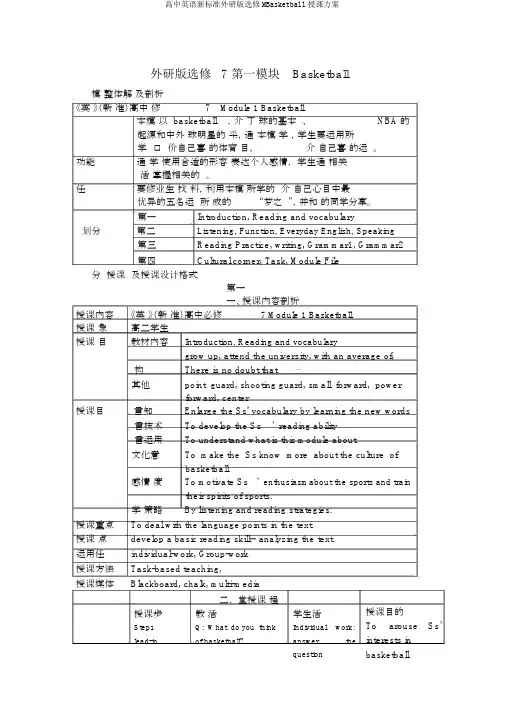
外研版选修7 第一模块Basketball模整体解及剖析《英》(新准)高中修7Module 1 Basketball本模以 basketball ,介了球的基本、NBA 的起源和中外球明星的采,通本模学,学生要运用所学口价自己喜的体育目,介自己喜的运。
功能通学使用合适的形容表达个人感情,学生通相关活掌握相关的。
任要修业生找料,利用本模所学的介自己心目中最优异的五名运所成的“梦之”,并和的同学分享。
第一Introduction, Reading and vocabulary划分第二Listening, Function, Everyday English, Speaking 第三Reading Practice, writing, Grammar1, Grammar2第四Cultural corner, Task, Module File分授课及授课设计格式第一一、授课内容剖析授课内容《英》(新准)高中必修7 Module 1 Basketball授课象高二学生授课目教材内容Introduction, Reading and vocabularygrow up, attend the university, with an average of, 构There is no doubt that⋯其他point guard, shooting guard, small forward, powerforward, center授课目言知Enlarge the Ss' vocabulary by learning the new words 言技术To develop the Ss’ reading ability言运用To understand what is this module about.文化意To make the Ss know more about the culture ofbasketball.感情度To motivate Ss’ enthusiasmabout the sports and traintheir spirits of sports.学策略By listening and reading strategies.授课重点To deal with the language points in the text.授课点develop a basic reading skill— analyzing the text.运用任individual-work, Group-work授课方法Task-based teaching,授课媒体Blackboard, chalk, multi-media二、堂授课程授课步教活学生活Step1 Q: What do you think Individual work: lead-in of basketball? answer thequestion 授课目的To arouse Ss’interests in basketballStep2 Assign the tasks: read Individual work Make sure Ss know Introduction this short passage and something about the finish Activity1,2,3. NBAStep3 Q:(1)what ’s your Individual work To develop Ss’Reading favorite basketball and group work ability to summarize players in NBA? the main ideas of(2)Do you know the each paragraphbasic information abouthim/her?(eg.Born,height, NBA career,etc.)Fast reading:Ask Ss toread the text quickly andcomplete the followingtable.Intensive reading: AskSs to read the passagecarefully and finish theexercises of Activities3~5.Step4 1) There is no doubt that Individual work To enlarge Ss’language he deserves the title vocabularypoints “ outstanding player ofhis generation ”2)He finished his firstseason as one of the topscorers in the league,points per game.Step5 Homework 1.Recite the new Individual work To strengthen and words review the 2.Ask Ss to preview knowledge we have listening and learned. speaking.第二课时一、授课内容剖析授课内容《英语》(新标准)高中必修 7 Module 1 Basketball授课对象高二学生授课项目教材内容Listening, Function, Everyday English, Speaking词语Lead by, in the lead结构non-attributive clause by which其他Stamina, tie, overtime授课目的语言知识to recognize the words and sentence structures and grasp theusage of them语言技术To promote the Ss ’ listening ability语言运用To practice the English in actual situation文化意识To make the Ss know more about the culture of basketballfurther.感神态度To motivate Ss’enthusiasm about the sports and train theirspirits of sports.学习策略By listening and speaking strategies.授课重点To find out the useful information to understand the meaning of the listeningmaterial授课难点How to get the main idea of the listening material运用任务individual-work, Group-work授课方法Task-based teaching,授课媒体Blackboard, chalk, multi-media二、课堂授课过程预设时间授课步骤教师活动学生活动授课目的Step1 Task: ask Ss to explain Individual work: To check up theLead-in the new words answer the results of previewquestion of SsStep2 Listening Task: finish the Individual work Make sure Ss knowActivity1-4 something about thelisteningStep3 Task: finish the Individual work To practice theFunction and exercises on P8 usage of words andEveryday English sentence structure.Step4 Speaking Q: “Everyone in China Group work To develop the Ss’thinks the NBA is speaking abilityfantastic. ”What is youropinion?Step5 Homework Ask Ss to preview Individual work To strengthen andreading and practice preview theand grammar. knowledge ahead oftime第三课时一、授课内容剖析授课内容授课对象授课项目《英语》(新标准)高中必修7 Module 1 Basketball高二学生教材内容Reading Practice, Writing, Grammar1, Grammar2 词语put it in this way, if necessary结构It's (not) in one's nature to do··其他hit, be gentle授课目的语言知识to recognize the words and sentence structures and grasp theusage of them语言技术To promote the Ss reading’and writing ability语言运用To enable the Ss to write a short essay文化意识To make the Ss know more about the culture of basketballfurther.感神态度To motivate Ss’enthusiasm about the sports and train theirspirits of sports.学习策略By listening and speaking strategies.授课重点To acquire the information of the passage to further develop the reading ability of Ss授课难点How to get the main idea of the each paragraph运用任务individual-work, Group-work授课方法Task-based teaching,授课媒体Blackboard, chalk, multi-media二、课堂授课过程预设时间授课步骤教师活动学生活动授课目的Step1 Task: ask Ss to explain Individual work: To check up theLead-in the new words answer the results of previewquestion of SsStep2 Task: Individual work To enable the Ss toReading 1.answer the Qs before and group word acquire useful morereading information2.finish exercises onthe textbook.Step3 Task: write a letter to a Individual work To develop the Ss ’sWriting newspaper about Yao writing abilityMingStep4 Conversion and Individual work To make Ss graspGrammar suffixes the vocabularyformationStep5 Ask Ss to preview Individual work To strengthen andHomework Cultural corner. preview theknowledge ahead oftime第四课时一、授课内容剖析授课内容《英语》(新标准)高中必修7 Module 1 Basketball授课对象高二学生授课项目教材内容Cultural corner, Task, Module File词语Shoot, hoop, referee, guard, slam dunk结构 a man called Alexander其他version, basis授课目的语言知识to recognize the words and sentence structures and grasp theusage of them语言技术To promote the Ss reading’ability further语言运用To infer the meaning from the passage文化意识To strengthen the awareness of basketball of the Ss感神态度To motivate Ss ’ enthusiasm about the sports andevelop theirawareness of sports.学习策略By reading strategies.授课重点To infer the information of the passage to further develop the reading ability ofSs授课难点How to infer the main idea from the paragraphs运用任务individual-work, Group-work授课方法Task-based teaching,授课媒体Blackboard, chalk, multi-media二、课堂授课过程预设时间授课步骤教师活动学生活动授课目的Step1 Task: ask Ss to explain Individual work: To check up theLead-in the new words answer the results of previewquestion of SsStep2 Task:answer the Qs Individual work To enable the Ss toCultural corner after reading and group word infer useful moreinformation Step3 Task: make a list of group work To develop the Ss ’sTask “dream team”ability ofcooperation Step4 Review by themselves Individual work To make Ss graspModule File the key points ofthis module Step5 Ask Ss to review the Individual work To strengthen andHomework whole module review theknowledge we havelearned。
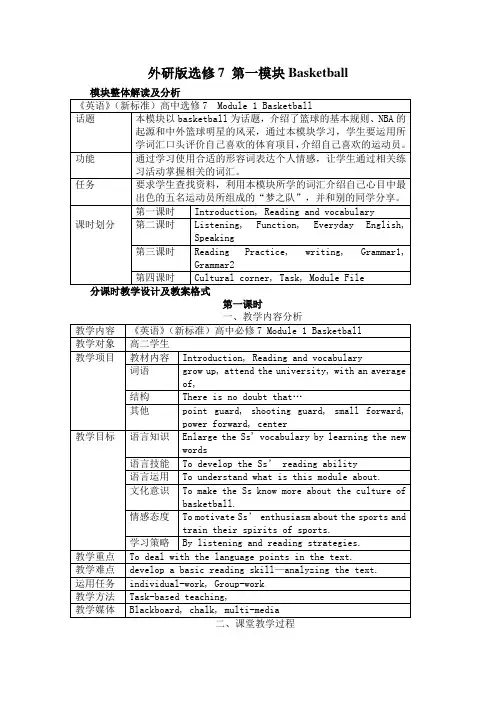
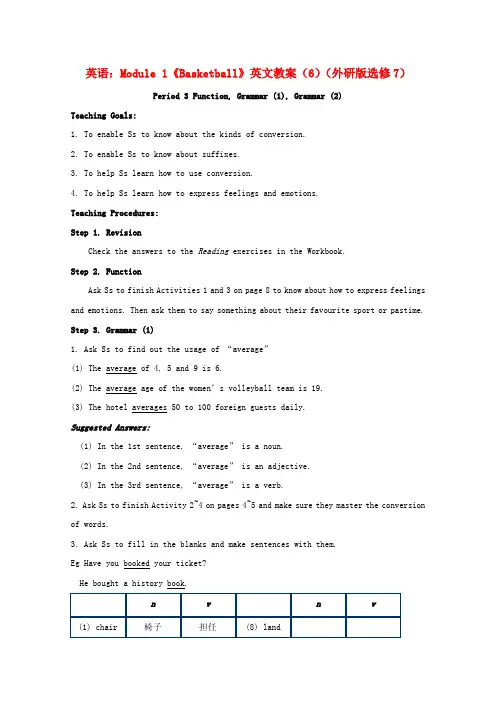
英语:Module 1《Basketball》英文教案(6)(外研版选修7)Period 3 Function, Grammar (1), Grammar (2)Teaching Goals:1. To enable Ss to know about the kinds of conversion.2. To enable Ss to know about suffixes.3. To help Ss learn how to use conversion.4. To help Ss learn how to express feelings and emotions.Teaching Procedures:Step 1. RevisionCheck the answers to the Reading exercises in the Workbook.Step 2. FunctionAsk Ss to finish Activities 1 and 3 on page 8 to know about how to express feelings and emotions. Then ask them to say something about their favourite sport or pastime. Step 3. Grammar (1)1. Ask Ss to find out the usage of “average”(1) The average of 4, 5 and 9 is 6.(2) The average age of the women’s volleyball team is 19.(3) The hotel averages 50 to 100 foreign guests daily.Suggested Answers:(1) In the 1st sentence, “average” is a noun.(2) In the 2nd sentence, “average” is an adjective.(3) In the 3rd sentence, “average” is a verb.2.Ask Ss to finish Activity 2~4 on pages 4~5 and make sure they master the conversion of words.3.Ask Ss to fill in the blanks and make sentences with them.Eg Have you booked your ticket?He bought a history book.Suggested Answers:(2) 手;上交 (3) 伤;受伤 (4) 画;绘画 (5) 味道;品尝 (6) 背部;支持(7) 卫兵;看守 (8) 土地;着陆 (9) 厨师;煮 (10) 步伐;行走 (11) 种类;分类(12) 名字;命名 (13) 热;加热 (14) 座位;坐Step 4. Grammar (2)1. Ask Ss to deal with all the exercises in Activities 1~4 on page 10 to let them know the grammatical points of suffixes..2.Ask Ss to work in pairs and summarize the usages of suffixes. Then give them the followingsummary.(1) 名词后加-fulpower—powerful wonder—wonderful(2) 名词后加-less构成与名词词义相反的形容词end—endless home—homeless(3) 名词后加-ichistory—historic artist—artistic(4) 名词后加-alenvironment—environmental nation—national(5) 名词后加-iveact—active expense—expensive(6) 名词后加-ouscourage—courageous danger—dangerous(7) 名词后加-ablecomfort—comfortable reason—reasonable(8) 名词后加-yrain—rainy cloud—cloudy(9) 名词后加-ist表示……人;主义者art—artist piano—pianist(10) 名词后加-ism表示……主义,行为,特征social—socialism Marx—Marxism(11) 名词后加-ese表示(…地方的)人;语言China—Chinese Japan—Japanese(12) 名词后加-ness表示……性质;状态ill—illness willing—willingness(13) 名词后加-hood表示……的状态;状况boy—boyhood child—childhood(14) 动词后加-er, -or构成表示人或物的名词lead—leader visit—visitor(15) 动词后加-(t)ion, (ation)表示动作;状态discuss—discussion graduate—graduation(16) 动词后加-ment表示……行为agree—agreement move—movementStep 5. Homework1. Ask Ss to review Grammar(1) and Grammar(2).2. Ask Ss to finish Grammar exercises in the Workbook on pages 91~92.。
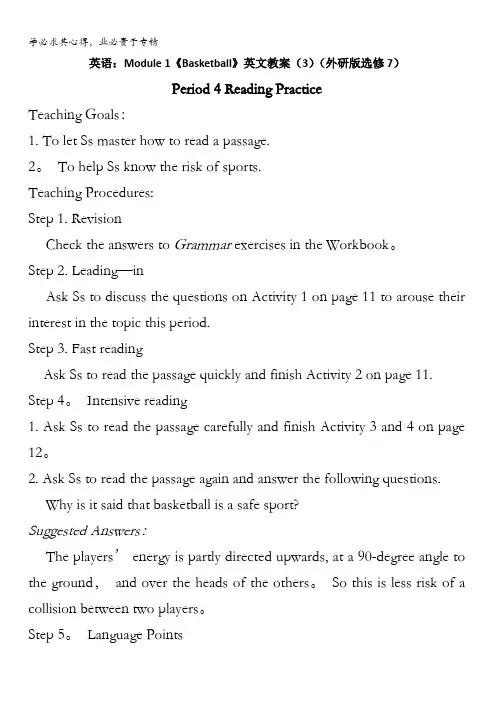
英语:Module 1《Basketball》英文教案(3)(外研版选修7)Period 4 Reading PracticeTeaching Goals:1. To let Ss master how to read a passage.2。
To help Ss know the risk of sports.Teaching Procedures:Step 1. RevisionCheck the answers to Grammar exercises in the Workbook。
Step 2. Leading—inAsk Ss to discuss the questions on Activity 1 on page 11 to arouse their interest in the topic this period.Step 3. Fast readingAsk Ss to read the passage quickly and finish Activity 2 on page 11. Step 4。
Intensive reading1. Ask Ss to read the passage carefully and finish Activity 3 and 4 on page 12。
2. Ask Ss to read the passage again and answer the following questions. Why is it said that basketball is a safe sport?Suggested Answers:The players’ energy is partly directed upwards, at a 90-degree angle to the ground,and over the heads of the others。
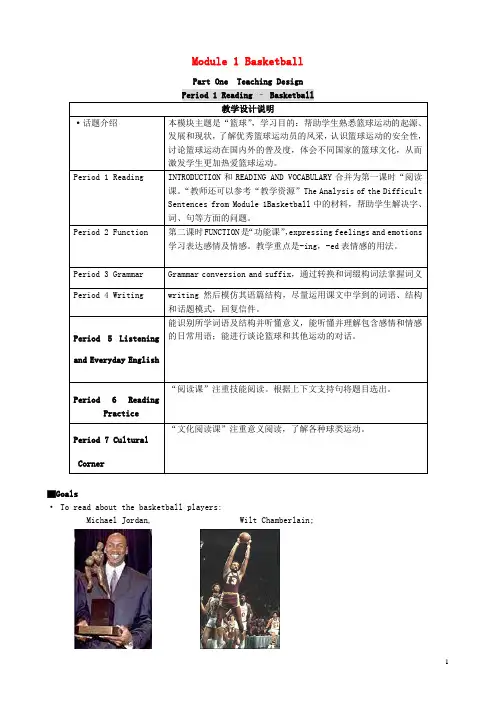
Module 1 BasketballPart One Teaching DesignPeriod 1 Reading –Basketball教学设计说明·话题介绍本模块主题是“篮球”,学习目的:帮助学生熟悉篮球运动的起源、发展和现状,了解优秀篮球运动员的风采,认识篮球运动的安全性,讨论篮球运动在国内外的普及度,体会不同国家的篮球文化,从而激发学生更加热爱篮球运动。
Period 1 Reading INTRODUCTION和READING AND VOCABULARY合并为第一课时“阅读课。
“教师还可以参考“教学资源”The Analysis of the DifficultSentences from Module 1Basketball中的材料,帮助学生解决字、词、句等方面的问题。
Period 2 Function 第二课时FUNCTION是“功能课”,expressing feelings and emotions学习表达感情及情感。
教学重点是-ing,-ed表情感的用法。
Period 3 Grammar Grammar conversion and suffix,通过转换和词缀构词法掌握词义Period 4 Writing writing然后模仿其语篇结构,尽量运用课文中学到的词语、结构和话题模式,回复信件。
Period 5 Listening and Everyday English 能识别所学词语及结构并听懂意义,能听懂并理解包含感情和情感的日常用语;能进行谈论篮球和其他运动的对话。
Period 6 ReadingPractice“阅读课”注重技能阅读。
根据上下文支持句将题目选出。
Period 7 CulturalCorner“文化阅读课”注重意义阅读,了解各种球类运动。
▇Goals· To read about the basketball players:Michael Jordan, Wilt Chamberlain;· To Learn to enjoy the titles■ProceduresStep 1: Warming up by learning IntroductionPlease think about the following questions:(1)Do you love team sports, such as football, basketball, volleyball?(2)Can you name some basketball players, at home or abroad? Do you know what positions they play?(3)What are the forwards doing---attacking or defending?(4)What is the referee doing?1.Fill in the blank with proper words.Let’s look at the picture on page 1 and what do the words mean?2.What is the NBA?Class, what basketball games do you love watching? Why?But do you know the history of the NBA? Let’s read the introduction. And reply to the following questions.Step 2: Practice for words studyOur school basketball team is awesome. Last year we _________ over 3,000 points. At the start of the season, our two star __________, Yang Hua and Xiao Ping _________ of getting 30 points each in every game. They didn’t manage that, but they _________ about 25 each. The game I remember best is the one where I _______ the ball through the basket six times in the first 15 minutes.Our coach said that was a _______ for our team. When the game was over, everyone jumped out of their seats and _______ for me; they wanted me to sign their programmes. My pen _________ becauseI had to write fast.Step 3: Before you read1. Information about Michael Jordan and Wilt ChamberlainClass, are you familiar with Michael Jordan and Wilt Chamberlain? Here is a poster to introduce the two star players in the USA. Read it and complete Exercise 1.2. Since you have known something about the two basketball players, who would like to compare them in different aspects?Step 4: While you read1. Fast reading for general ideas of the textShall we get the details of the two famous basketball players? As we have known, they are outstanding and are well thought of in the history of basketball. Read the two titles and they are meaningful. “Michael Jordan--- Head and Shoulder Above the Rest”. Look at yourself, and your head and shoulder are always above the rest of the other parts of your body. It means somebody is much better than others. “Wilt the Stilt --- the Tower of Power” Class, have you ever seen people walk on stilts in the Spring Festival? They are taller than people who don’t. As we know, Chamberlain was even 19 centimeters taller than Jordan. He was not only tall but also full of power and magic on the basketball court.Comprehension—understanding what you are reading—is important. To read in thought groups is an easy, yet effective, way of improving reading comprehension. (Divide the whole class into two groups) Group A read the first passage about Jordan and group B read the other. And then introduce the basketball player to each other by using the information of the text. (a form of finding topic sentence or general idea of each paragraph)Now read the recording of the text. Pay attention to the details while listening and reading.2. Fill in the formFor reference:3. Complete the article with one word in each blankDuring the 1990s, Michael Jordan was probably the ___________ athlete in the world. He was _________ the most valued player five times. Millions of fans admire his athletic ability, ___________and confidence. Off the basketball __________, Michael Jordan opened his own steak restaurant and he also found ________ as an actor.The first player to _________ more than 3,000 points in a ________ was Wilt Chamberlain. He is the only NBA player who _________ over 50 points per game for an entire season. There is no _________ that he __________ the title “outstanding player of his generation”.Step 5: After you read1. Retell the text2. Introduce the two famous sportsmen附:面对高考该怎么复习?1、回归课本。
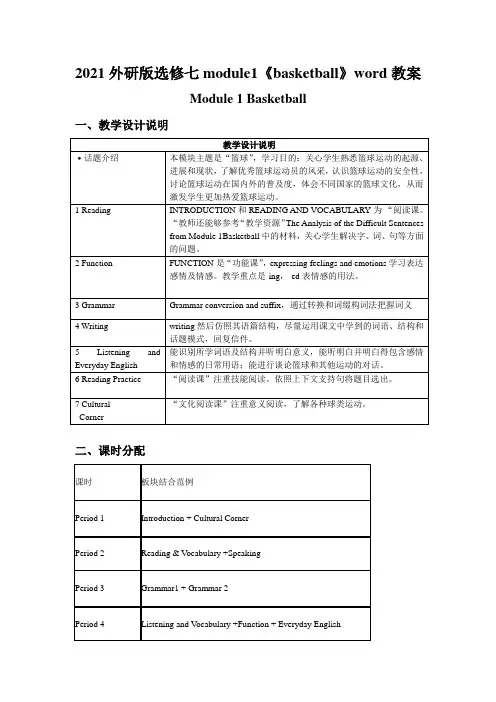
2021外研版选修七module1《basketball》word教案Module 1 Basketball一、教学设计说明二、课时分配三、教学过程Period 1Module 1 BasketballIntroduction +Cultural CornerI. Vocabulary and speakingQuestions:1.What is the picture about?2.How many players does each team have on a basketball court during the match?3.How do the players divide up their teamwork during the match?4.How many basketball players do you know in NBA?hoopforwardcourtrefereeguardBasketballslam dunkbasketReadingCourt--- the playing areaHoop--- the circular metal band which is attached to the backboard and holds the basket Basket--- the rope through which the ball must pass in order to score pointsSlam dunk--- one of the shots with which a player can scoreReferee--- the person who controls the gameForward--- an attacking player, who tries to score pointsGuard--- a defending player, who tries to stop the forwards scoringBasketball TermsMichael JordanBorn:17th February 1963Height:1.98mNBA career:15 seasons(first season 1984-1985)Position:GuardGames:1,072Points:32,292Record holder:1.Most seasons leading scorer:102.consecutive seasons leading scorer:7(1987-1993)Wilt ChamberlainBorn:21st August 1936Died:12th October 1999Height:2.17mNBA career:14 seasons(first season 1959-1960)Position:CentreGames:1,045Points:31,419Record holder:1.Most Points in a season:4,029(1961-1962)2.Consecutive seasons leading scorer:7(1960-1966)What is the main difference between basketball and these sports?basketballvolleyballFootballfootball(soccer)tennisbaseballV olleyballtennistennisLina, who is a good tennis player, attends to the international tennis competition on behalf of China. She is also the new hope of China in tennis sports.Chinese Women Volleyball Team had ever won the consecutive five champion of the world cup of volleyball.Wilt Chamberlain in the raceMichael Jordan in the raceWhat a wonderful slam dunk!He is one of the greatest basketball athletic in the NBA history.Yaoming is not only a new star among the basketball players but also the only Chinese athletic playing basketball in the NBA. All the Chinese people are very proud of his achievement in basketball sports.Yaoming in the raceThe basketball games is very popular in America , most people enjoy watching the NBA race in their spare time.Competition between the teams in the NBACompetition between the teams in the NBAThe Slam Dunk ShowIntroduction-1 brainstorming (5m) Talk about the following pictures.Discussion:Do you like playing or watching basketball? Why?ballbasketbasketballIntroduction-2. Free talk (4m)Which of these words would you use to describe basketball?boring complicated dangerous exciting fast simple slow Introduction-3. DiscussionWhich is your favourite basketball team?dream team 梦之队Detroit Pistons底特律活塞队Phoenix Suns凤凰城太阳队LA Lakers 洛杉矶湖人队Houston Rockets 休斯敦火箭队Miami Heat 迈阿密热浪队Chicago Bulls 芝加哥公牛队Who is your favourite basketball player?Please give a brief introduction of those basketball players.Introduction-4.Ask and answer(3m) Answer questions in activity 1.How many teams are there in a basketball match? 2How many players does each team have on a basketball court during the match? 53. How do the players divide up their teamwork during the match? 5 positionsIntroduction –5. Review the words(3m)__________ is the playing area.__________ is the circular metal band which is attached to the backboard and holds the basket.__________is the rope through which the ball must pass in order to score points.__________is one of the shots with which a player can score.CourtHoopBasketSlam dunk5. ____________is a defending player who tries to stop the forwards scoring.6. ____________ is the person who controls the game.7. ____________ is an attacking player, who tries to score points.GuardRefereeForwardIntroduction ---Do Activity 2 read the passage about NBAWhat is NBA?NBA stands for ________________________________________. It is the number one basketball __________ in the world.the National Basketball AssociationleagueThe keys to activity 21. Yes, they are now.2. No. they aren’t (USA and Canada)3. The players in a professional team get paid. It is their job to play basketball.Introduction---Do Activity 3, part 2 the main difference between basketball and other sports1. Football and basketballIn football you score by ___________ or ________ the ball into a _______; in basketball you score by ___________________________________ with your _________.2. Baseball and basketballIn baseball you ______the ball with a ____, then run around the _________ to score.in basketball you _____with the ball to score.kickingheadinggoalputting the ball through the baskethandshitbatdiamondrun3. Tennis and basketballIn tennis you hit the ball with a _______ backwards and forwards over a _______; in basketball there are no ________or _______. But both games are played on a ________.4. V olleyball and basketballIn volleyball you play in _______, but each team is on one side of a high ______. You hit the ball with your _______, but you can’t catch it like in basketb all.racketnetracketsnetscourtteamsnethandsII.Cultural Corner---1. Warm-upbasketballAmerican football (rugby)baseballCultural Corner---2.Read cultural corner and fill the form(try to write down the keyCultural Corner---Reading and Note-takingRead the passage again and underline some important words or phrases.American football (rugby)1. Football or ______ started in ______ with a _______ball that players ______but could not_____.2. In 1823, a _______ picked up the ball during the soccer game and _______with it . His classmates enjoyed it . Later, rugby was played with an _____ ball that could be both ________ and _________3. Rugby was _________ to the USA and became _________sport that Americans now call it _______. However, people in China _______ play it.soccer England round kicked carry pupil ran oval carried thrown exported popular football seldom Basketball1. It was invented in 1891 in a _______________by a _______________ teacher who wanted to ______ exercise ____ a noisy class. He ______ two basket ____ two tall poles and asked the players to throw the ball into the baskets.2. The 13 rules he wrote are the ________ of modern basketball rules.3. Basketball is very _______in the world.gymnasium physical education provide for attached to basis popular Baseball1. It __probably_____ ___ an old English game called rounders.2. A _________of the game became popular in the early 19th Century. Modern rules of the game are very similar to his __________rulesis based on version originalIII.Homework1. Try to find some information about basketball and learn some specific terms of it.2. Preview the Reading and V ocabularyPeriod 2Module 1 BasketballReading & VocabularySpeakingI.Reading & VocabularyReading & V ocabulary -1Speaking –talking about some famous playersMichael JordanBorn:17th February 1963Height: 1.98mNBA career: 15 seasons(first season 1984- 1985)Position: GuardGames: 1, 072Points: 32, 292Record holder:Most seasons leading scorer: 10Consecutive seasons leading scorer: 7 (1987-1993)Wilt ChamberlainBorn: 21st August 1936Died:12th October, 1999Height: 2.17mNBA career: 14 seasons (first season 1059-1960)Position: CentreGames: 1,045Points: 31,419Record holder:Most points in a season: 4,029(1961-1962)Consecutive seasons leading scorer: 7(1960-1966)Reading & V ocabulary -2. Speaking – talk about them according to the informationGive a brief introduction of the two basketball players.eg. Michael Jordan/ Wilt Chamberlainwas born on…Reading and Vocabulary---3. Fast-reading (6m) Read the information quickly and answer the questionsKeys to the questionsNo, they didn’t.19 cmJordan63Consecutive seasons leading scorer.Reading & V ocabulary -3.Detailed-reading (6m) Read the passage about Michael Jordan then work your partner to get more information.Keys to Activity 2 (1-3):The Chicago Bulls, the United states Olympic.6 times (1991, 1992, 1993, 1996, 1997, 1998)Because of his athletic ability, his motivation and his confidence.Keys to Activity 3 (1-4): T, F, T, TReading & V ocabulary -4. Language focusHe was named their ____ _____ _____ (最有价值球员) five times.Jordan was born in New York and ____ ___ (长大) in North Carolina.He ________(就读) the University of North Carolina for a year before leaving to join the Chicago Bulls.He finished his first season (1984-1985) as one of the top scorers in the______ (联赛), ____ __ _______ ___ (平均为……) 28.2 points per game.most valued playerupgrewattendedleaguewith an average of5. Jordan surprised everyone when he _____(退休) before the 1993-1994 season, but he _______(再次加入) the Chicago Bulls and won three more _____________(冠军,冠军赛) with them from 1996 to 1998.6. Millions of fans ______(钦佩) his ______(运动的) ability, __________ (动力) and confidence.retiredrejoinedchampionshipsadmireathleticmotivationThey have fantastic stories to tell about Michael Jordan such as the time when he _______(挽救) the Bulls from ending a game on a _____(平局).Each time he threw the ball ______ ______ (直截了当穿过) the basket –and each time he ___ ___ ____ ______(闭上他的眼睛).___ the basketball ____ (球场), Michael Jordan opened his own _____(牛排) restaurant because he loves steak so much.rescuedtiestraight throughhad his eyes closedOffcourtsteak10. He also found success as an actor in the film Space Jam ________(在……旁) the famous cartoon character Bugs Bunny!11. There is only one word to describe the best player in the world –_________(令人敬畏)! alongsideawesomeI Believe I Can FlyReading & V ocabulary-5.Detailed-reading (6m) Read the passage about Wilt Chamerlain then work your partner to get more information.Keys to Activity 2 (4-6):4. 4 teams.5. Philadelphia Warriors/ Los Angeles Lakers.6. Because he was very tall and strong.Keys to Activity 3 (5-8): T, F,T,TReading & V ocabulary -6. Language focusHis father William worked in a ________ (造船厂)and his mother Olivia was a cleaner.As a child, Chamberlain had _______ (各种各样的)health problems. He had —__________ (肺炎) and almost died when he was ten.Chamberlin is the only NBA player who ________ (平均为v.) over 50 points per game for an _____ (整个) season.shipyardvariouspneumoniaaveragedentireThe giant player joined the NBA’s Philadelphia Warriors in the 1959-1960 season and was an_________ (赶忙的) success.The final _____ (分数) was Warriors 169 New York Knicks 147!But there is no doubt that he _______ (值得) the title “____________(杰出的) player of his ___________(代)”.immediatescoredeservesoutstandinggenerationReading & V ocabulary -7.Exercises (3m) Finish the exercise on Activity 4 Page 4.gold medalscoreconsecutiveleagueseason6. dream team7. motivation8. awesome9. alongsideReading & V ocabulary -8.Exercises (3m) Finish the exercise on Activity 5 Page 4Keys:BBABABII.SpeakingAsk students work in groups to discuss the questions in Activity 1 and activity 3.Check their work and ask some students to give a report of their workIII.Homework1.Write a short biography of Michael Jordan or Wilt Chamberlain within 100 words.2. Preview the grammar part.Period 3Module 1 BasketballGrammarI.GrammarGrammar---Activity 1Read the sentences and answer the questions.a) averaged/average: in the first sentence “averaged” is a verb describing what Chamberlain did; in the second sentence “average” is a noun telling us what we are talking about.score/score: in the first sentence “score” is part of “to score” the infinitive of the verb telling us what Jordan did; in the second sentence “score” is a noun telling us what we are talking about.b) No, it doesn’t.Grammar ---Do Activity 2 and 3Activity 21 win2 a surprise3. a changeActivity 31 verb: dream2 noun: result3 noun: star4 verb: worked5 noun: questionsGrammar ---Do Activity 4 and 5Activity 41 broke2 head3 record4 played5 headed6 recorded7 play8 breakActivity 51 don’t change: drink; walk;2 change:watch; mind; plan;Summary---构词法合成combination派生derivation ---prefix,suffix转化conversion缩写简写short form词的转化(Conversion)1)名词转化为动词paper — to paper the roommouth — to mouth some phrasesshoulder — to shoulder the heavy loadbandage — to bandage the leg2)动词转化为名词to say something — to have a sayto show — to give a showto feel — to have a feel tolead — to take a lead3)形容词转化为动词empty — to empty the bagwrong — to wrong somebodyslow — to slow downbetter — to better your study4 )副词转化为动词back — to back a cardown — to down a planenear — to near the templeforward — to forward a message5)形容词转化为名词calm — a calm on the seahigh — a new high of the industrygood — a lot of good有些词的词性转化后,词的重音发生变化export / ' ekspo:t/ n. 出口/ik'spo :t/ v.出口import / ' impo :t/ n. 进口/im'po:t/ v.进口permit / ' p ә :mit/ n. 许可证/p ә 'mit/ v. 准许present / ' prez ә nt/ n. 礼物/pri ' zent/ v. 赠送increase / ' inkri:s/ n.增加/in'kri:s/ v. 增加record / ' reko:d/ n.唱片/ri ' ko:d/ v.记录Grammar 2---Do Activity 1 and 2Activity 11. beautiful2. careful3. hopeful4. painful5. powerful6. wonderfulActivity 21 powerful2 painful3 careful4 hopeful5 wonderfulGrammar2---Do Activity 31 It means that it is "full" of that quality, e.g. hopeful = full of hope2 It is without the quality described by the noun, e.g. hopeless = without hope3 power, hope, care, pain4 endless — limited;homeless — home-owning;selfless — selfish;worthless — valuableGrammar 2---Do Activity 4artisticathleticdramaticenergeticfantasticGrammar 2---Activity 51 In the floor exercises in gymnastics you have to be athletic and artistic.2 You have to be very energetic to be a professional sportsman or woman.3 Some football matches are very dramatic, with extra time and penalty shoot-outs.4 When your team wins a cup, it's a fantastic feeling.Summary通过在词根上加前缀或后缀构成另一个词叫词的派生。
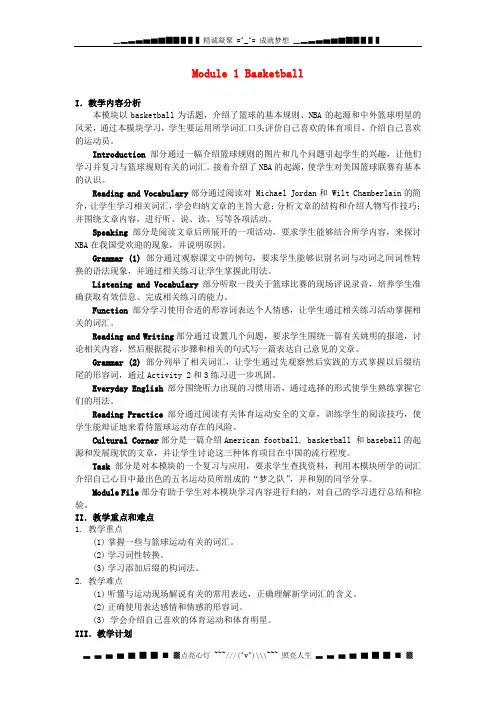
Module 1 BasketballI.教学内容分析本模块以basketball为话题,介绍了篮球的基本规则、NBA的起源和中外篮球明星的风采,通过本模块学习,学生要运用所学词汇口头评价自己喜欢的体育项目,介绍自己喜欢的运动员。
Introduction 部分通过一幅介绍篮球规则的图片和几个问题引起学生的兴趣,让他们学习并复习与篮球规则有关的词汇。
接着介绍了NBA的起源,使学生对美国篮球联赛有基本的认识。
Reading and Vocabulary部分通过阅读对 Michael Jordan和 Wilt Chamberlain的简介,让学生学习相关词汇,学会归纳文章的主旨大意;分析文章的结构和介绍人物写作技巧;并围绕文章内容,进行听、说、读、写等各项活动。
Speaking部分是阅读文章后所展开的一项活动,要求学生能够结合所学内容,来探讨NBA在我国受欢迎的现象,并说明原因。
Grammar (1) 部分通过观察课文中的例句,要求学生能够识别名词与动词之间词性转换的语法现象,并通过相关练习让学生掌握此用法。
Listening and Vocabulary部分听取一段关于篮球比赛的现场评说录音,培养学生准确获取有效信息、完成相关练习的能力。
Function部分学习使用合适的形容词表达个人情感,让学生通过相关练习活动掌握相关的词汇。
Reading and Writing部分通过设置几个问题,要求学生围绕一篇有关姚明的报道,讨论相关内容,然后根据提示步骤和相关的句式写一篇表达自己意见的文章。
Grammar (2) 部分列举了相关词汇,让学生通过先观察然后实践的方式掌握以后缀结尾的形容词,通过Activity 2和3练习进一步巩固。
Everyday English部分围绕听力出现的习惯用语,通过选择的形式使学生熟练掌握它们的用法。
Reading Practice部分通过阅读有关体育运动安全的文章,训练学生的阅读技巧,使学生能辩证地来看待篮球运动存在的风险。
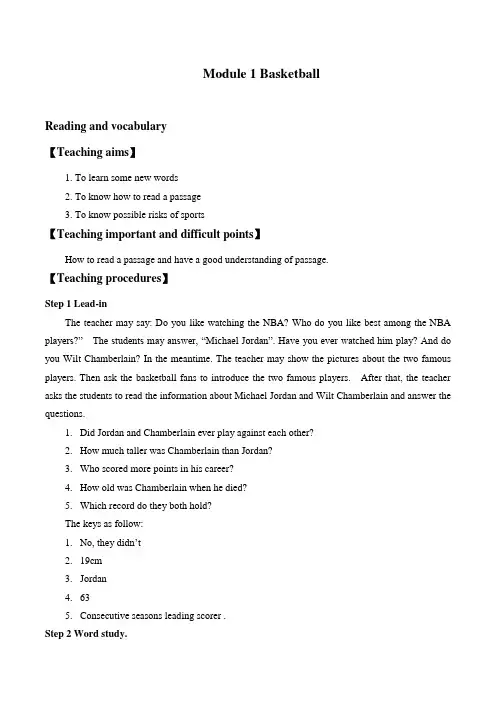
Module 1 BasketballReading and vocabulary【Teaching aims】1. To learn some new words2. To know how to read a passage3. To know possible risks of sports【Teaching important and difficult points】How to read a passage and have a good understanding of passage.【Teaching procedures】Step 1 Lead-inThe teacher may say: Do you like watching the NBA? Who do you like best among the NBA players?” The students may answer, “Michael Jordan”. Have you ever watched him play? And do you Wilt Chamberlain? In the meantime. The teacher may show the pictures about the two famous players. Then ask the basketball fans to introduce the two famous players. After that, the teacher asks the students to read the information about Michael Jordan and Wilt Chamberlain and answer the questions.1.Did Jordan and Chamberlain ever play against each other?2.How much taller was Chamberlain than Jordan?3.Who scored more points in his career?4.How old was Chamberlain when he died?5.Which record do they both hold?The keys as follow:1.No, they didn’t2.19cm3.Jordan4.635.Consecutive seasons leading scorer .Step 2 Word study.hold v. 保持consecutive adj 连续的,不间断的title n. (重大体育比赛中的)冠军centre n. (足球,篮球等的)中锋scorer n. (进球得分的)运动员Step 4 Fast-readingRead the passage and answer the questions five minutes given.1.Which basketball team did Michael Jordan play for?2.How many times did Michael Jordan’s team win the NBA title?3.Why do the fans admire Jordan so much?The answers:1.The Chicago Bulls, the United States Olympic Basketball Team, and the Washington Wizards.2. 6 times (1991, 1992, 1993, 1996, 1997, 1998.3.Because of his athletic ability, his motivation and his confidence.Step 5 Learn the new words by using the sentences from the text and pictures v alued: Michael Jordan was named the Chicago Bulls’ most valued player five times and hebecame the most successful basketball player in the history of the game. .grow up : Jordan grew up in North Carolina.attend: Jordan attended the University of North Carolina for a year before leaving to join the Chicago Bulls.with an average of : He finished his first season as one of the top scorers in the league, with an average of 28.2 points per game.gold medal 金牌Millions of fans admire his athletic ability, motivation and confidence.Jordan rescued the Bulls from ending a game on a tie.Jordan loves the steak so much.alongside prep 靠着;并排Jordan is an awesome player.Step 6 Judge the sentences true or false.1.Michael Jordan is the best—known athlete in the world.2.Jordan finished his studies before he joined the Chicago Bulls.3.Jordan was the second person to score more than 3,000 points in a season.4.Jordan made a film in which he acted with a cartoon character.the key:1.True2.False--- he only studied for a year.3.True4.TrueStep 7 Read the second part of the text---- Wilt the Stilt ---- the Tower of Power. Please answer three questions.1)How many basketball teams did Wilt Chamberlain play for?2)Which were the first and last teams Wilt Chamberlain played for?3)Why is Wilt Chamberlain called the Tower of Power?The key:1) 4 teams2)Philadelphia Warriors/ Los Angeles3)Because he was very tall and strong.Step 8 word -learning1) His father William worked in a shipyard. n. 造船厂,船坞2) As a child, Chamberlain had various health problem. adj. 各种各样的3) Chamberlain averaged over 50 points per game for an entire season. adj. 全部的,整个的。
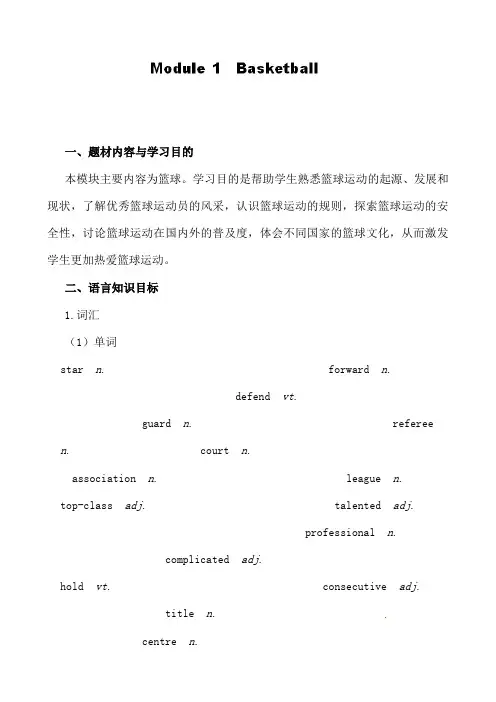
一、题材内容与学习目的本模块主要内容为篮球。
学习目的是帮助学生熟悉篮球运动的起源、发展和现状,了解优秀篮球运动员的风采,认识篮球运动的规则,探索篮球运动的安全性,讨论篮球运动在国内外的普及度,体会不同国家的篮球文化,从而激发学生更加热爱篮球运动。
二、语言知识目标1.词汇(1)单词star n.forward n.defend vt.guard n. referee n.court n.association n. league n.top-class adj.talented adj.professional n.complicated adj.hold vt.consecutive adj.title n.centre n.valued adj.attend vt.average n.per prep.motivation n.steak n.alongside prep.awesome adj.various adj.entire adj.immediate adj.deser ve v.genera tion n.live adv.half n.quarter n.selfish adj. nature n.instant adj.hit n.nationwide adj.boxing n.upwards adv.angle n.collision n.parallel adj.adequate adj.sock n.sneaker n.absorb vt.version nvest n.abrupt adj.accelerate vi.bounce n.tournament n.interval n.appoint vt.typical adj.slim adj.stout adj. belly nobtain vt.circuit n.boundary n. controversial adj.aside adv.dip vt.commit vt. suspension n.howl vi.bleed vi.cheek n confirm vt.dizzy adj.bandage n.b lanket n.ambulance n.considerat e adj. apologise vi.sniff vi. weep vi.teamwork n.scar n.oval adj.g ymnasium n. pole n.basis n.(2)短语all the timebe based onbe rude tobe used to draw sb’s attention togrow upifnecessaryin the history oftake possession ofThere’s no doubt that ...with an average of2. 语法(1)词的转化export, import, increase, permit, record, present等。
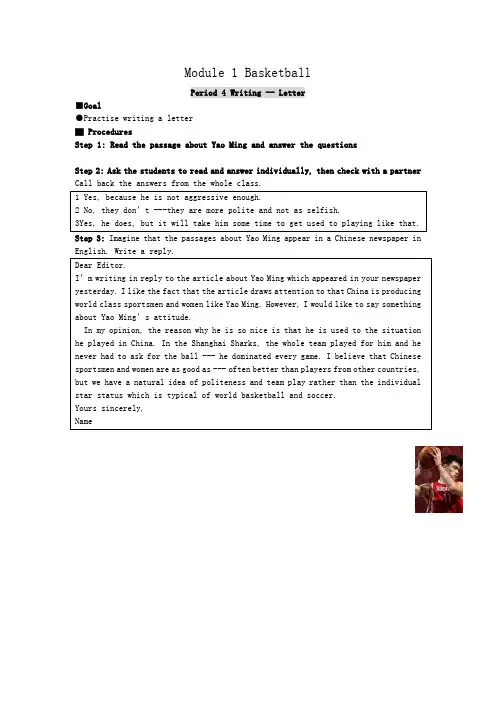
![高中英语 Module 1 Basketball-Period 3[TY]课件 外研版选修7](https://uimg.taocdn.com/5c3c710bf111f18583d05ac4.webp)
Module One Language PointsReading and Vocabulary1. Jordon surprised everyone when he retired before the 1993-1994 season, but he rejoined the Chicago Bulls and won three more championships with them from 1996 to 1998. 1993-1994赛季之前乔丹退役,引起举世震惊,但后来他又回到了芝加哥公牛队,并和队友们一起在1996到1998年间又获得了三次冠军。
动词前面加前缀re- 表示“重新,又,再”,rejoin 的意思是再次加入,类似的动词还有rebuild, replace, remarry, reuse, rewrite2. They have fantastic stories to tell about Michael Jordan, such as the time when he rescued the Bulls from ending a game on a tie. 他们可以讲述很多关于迈克尔·乔丹的传奇故事,例如一次他在比赛的关键时刻拯救了公牛队,从而避免打成平局。
1. rescue …from…把…从某种状态拯救出来They rescued a child from drowning.他们救起一落水儿童。
The lifeboat rescued the sailors from the sinking boat.The government has refused to rescue the company from bankruptcy.come to one’s rescue 拯救2. end a game on a tie/ draw 打成平局3. At one point, Chamberlain was so much better than all the other players that they changed the rules of the game to try to stop him.曾几何时,张伯伦比其他的队员都优秀的多,以至于他们改变了比赛规则来企图限制他。
Module 1 Basketball_Period3新课教学过程3(外研版选修7)Period 4 Reading and WritingTeaching Goals:1. To develop Ss ’ reading ability.2. To enable Ss to write a reply and learn to express personal opinions.Teaching Procedures:Step 1. Leading-in1. Ask Ss to discuss the following questions to arouse their interest of Chinese basketball players.(1) Do you like watching basketball or playing yourself?(2) Do you like watching the NBA?(3) Who do you like best among the NBA players?(4) Are there any Chinese players in the NBA? If so, who are they?(5) Which Chinese player do you think is now going on well in the NBA?(6) Do you like him? Why? Which team is he in now?2. Ask Ss if they know something about Yao Ming. Then let them fill in the following table.Suggested Answers:(1) September, 1980.(2) Shanghai.(3) 2.26m.(4) Center.(5) Both of his parents are basketball players.Step 3. Reading1. Ask Ss to read the passage about Yao Ming and answer the questions.(1) Is the Houston Rockets coach disappointed with Yao Ming?(2) Do Chinese basketball players play in the same way as US player?(3) Does Yao Ming understand what the coach wants him to do?(4) Who is the coach of the Houston Rockets?(5) What is Yao’s nature? What is not his nature?Suggested Answers:(1) Yes, because he is not aggressive enough.(2) No, they don’t. they are more polite and not as selfish.(3) Yes, he does, but it will take him some time to get used to playing like that.(4) Jeff Van Gundy(5) Yao is a selfless and kind person. It i s not in his nature to be “selfish” and “rude”.Step 4. DiscussionAsk Ss to talk something about “aggressive behavior”, and then share their opinions about the following questions.(1) Can you think of some examples of aggressive behaviors?(2) To compete with players from other countries, what must Chinese athletes do? What do they lack? And what are they good at?Step 5. WritingAsk Ss to w rite a reply after reading the passage about Yao Ming’s attitude and behavior in NBA, and provide a model for them.Step 5. HomeworkAsk Ss to finish the writing task and hand it in the next period.Period 6 Task, Cultural Corner, Module FileTeaching Goals:1. To enable Ss to know other sports around the world.2. To help Ss review what we have learnt in this module.3. To let Ss learn how to prepare a “dream team ”.Teaching Procedures:Step 1. RevisionLet Ss to do a presentation of their writing.Step 2. TaskAsk Ss to say their “dream team ” of the star players in groups and then choose the best to read to the rest of the class.Step 3. Cultural Corner1. Enable Ss to talk about the following sports and share each other ’s experience to lead in the topic of this period.Baseball American football Basketball(1) Which of these games do you think is the most enjoyable to play?(2) How popular are these games in China?2. Ask Ss to read part 1 and fill in the blanks.Suggested Answers:(1) American football(2) in 1823(3) at Rugby School in England(4) William Webb Ellis(5) picked up the ball during a soccer game and ran with it, …3. Ask Ss to read part 2 and fill in the blanks.(1) basketball(2) in 1891(3) in a gym in Springfield, Massachusetts(4) Dr James Naismith(6) create a game that would provide exercise for a noisy class4. Ask Ss to read part 3 and fill in the blanks.Suggested Answers:(1) baseball(2) unknown(3) unknown(4) unknown(5) based on an old English game called rounders, a version of the game became popular inthe early 19th century; Alexander Cartwright wrote the rules for baseball in 1845.Step 4. Module FilePurpose: To enable Ss to make a conclusion of this module and deepen what they have learned in the module.Ask Ss to look at Module File on page 14 and try to recall what they have learnt in themodule. Then tick the things they are sure that they know and put a question mark next to the points they are not sure of and a cross to what they don’t know.Help Ss to share their ideas and deal with the difficult or confusing points.Ask Ss to read some articles or novels about sports to strengthen their reading skills and enlarge their vocabulary.Step 5. Homework1. Ask Ss to revise this module.2. Ask Ss to finish the rest of the exercises in the Workbook of this module.3. Ask Ss preview module 2.。
Module 1 BasketballPeriod 3 Grammar -- Conversion and Suffix■Goal●Learn conversion and suffix▇ ProceduresStep 1: conversion 词性转化“Conversion” (called sometimes “full conversion”) is a word-formation process by which a word is altered from one part of speech into another without the addition (or deletion) of any morpheme.词性转化指的是单词从一个词类转到另一个词类而不发生词形变化。
1. noun →verbpaper―to paper the roommouth―to mouth some phraseshoulder―to shoulder the heavy loadbandage―to bandage the leg2. verb→nounto say something―to have a sayto show ―to give a showto feel ―to have a feelto lead―to take a lead3. adj.→verbempty―to empty the bagwrong ―to wrong somebodyslow― to slow downbetter―to better your study4. adv.→verbback―to back a cardown―to down a planenear― to near the templeforward― to forward a message5. adj.→ noun.calm― a calm on the seahigh― a new high of the industrygood― a lot of goodright― to tell from right to wrongStep 2: suffix 后缀构词法包括合成、派生、转化和缩写简写。
Module 1 Basketball_Period 2新课教学过程(2)(外研版选修7)Module 1 BasketballPeriod 3 Function, Grammar (1), Grammar (2)Teaching Goals:1. To enable Ss to know about the kinds of conversion.2. To enable Ss to know about suffixes.3. To help Ss learn how to use conversion.4. To help Ss learn how to express feelings and emotions.Teaching Procedures:Step 1. RevisionCheck the answers to the Reading exercises in the Workbook.Step 2. FunctionAsk Ss to finish Activities 1 and 3 on page 8 to know about how to express feelings and emotions. Then ask them to say something about their favourite sport or pastime. Step 3. Grammar (1)1. Ask Ss to find out the usage of “average”(1) The average of 4, 5 and 9 is 6.(2) The average age of the women’s volleyball team is 19.(3) The hotel averages 50 to 100 foreign guests daily.Suggested Answers:(1) In the 1st sentence, “average” is a noun.(2) In the 2nd sentence, “average” is an adjective.(3) In the 3rd sentence, “average” is a verb.2.Ask Ss to finish Activity 2~4 on pages 4~5 and make sure they master the conversion of words.3.Ask Ss to fill in the blanks and make sentences with them.Eg Have you booked your ticket?(2) 手;上交 (3) 伤;受伤 (4) 画;绘画 (5) 味道;品尝 (6) 背部;支持(7) 卫兵;看守 (8) 土地;着陆 (9) 厨师;煮 (10) 步伐;行走 (11) 种类;分类(12) 名字;命名 (13) 热;加热 (14) 座位;坐Step 4. Grammar (2)1. Ask Ss to deal with all the exercises in Activities 1~4 on page 10 to let them know the grammatical points of suffixes..2.Ask Ss to work in pairs and summarize the usages of suffixes. Then give them the followingsummary.(1) 名词后加-fulpower—powerful wonder—wonderful(2) 名词后加-less构成与名词词义相反的形容词end—endless home—homeless(3) 名词后加-ichistory—historic artist—artistic(4) 名词后加-alenvironment—environmental nation—national(5) 名词后加-iveact—active expense—expensive(6) 名词后加-ouscourage—courageous danger—dangerous(7) 名词后加-ablecomfort—comfortable reason—reasonable(8) 名词后加-yrain—rainy cloud—cloudy(9) 名词后加-ist表示……人;主义者art—artist piano—pianist(10) 名词后加-ism表示……主义,行为,特征social—socialism Marx—Marxism(11) 名词后加-ese表示(…地方的)人;语言China—Chinese Japan—Japanese(12) 名词后加-ness表示……性质;状态ill—illness willing—willingness(13) 名词后加-hood表示……的状态;状况boy—boyhood child—childhood(14) 动词后加-er, -or构成表示人或物的名词lead—leader visit—visitor(15) 动词后加-(t)ion, (ation)表示动作;状态discuss—discussion graduate—graduation(16) 动词后加-ment表示……行为agree—agreement move—movementStep 5. Homework1. Ask Ss to review Grammar(1) and Grammar(2).2. Ask Ss to finish Grammar exercises in the Workbook on pages 91~92.。
Module 1 Basketball
Period 3 Grammar -- Conversion and Suffix
■Goal
●Learn conversion and suffix
▇ Procedures
Step 1: conversion 词性转化
“Conversion” (called sometimes “full conversion”) is a word-formation process by which a word is altered from one part of speech into another without the addition (or deletion) of any morpheme.
词性转化指的是单词从一个词类转到另一个词类而不发生词形变化。
1. noun →verb
paper―to paper the room
mouth―to mouth some phrase
shoulder―to shoulder the heavy load
bandage―to bandage the leg
2. verb→noun
to say something―to have a say
to show ―to give a show
to feel ―to have a feel
to lead―to take a lead
3. adj.→verb
empty―to empty the bag
wrong ―to wrong somebody
slow― to slow down
better―to better your study
4. adv.→verb
back―to back a car
down―to down a plane
near― to near the temple
forward― to forward a message
5. adj.→ noun.
calm― a calm on the sea
high― a new high of the industry
good― a lot of good
right― to tell from right to wrong
Step 2: suffix 后缀
构词法包括合成、派生、转化和缩写简写。
词缀是派生的一部分。
The basic part of any word is the root; to it, you can add a prefix at the beginning and/or a suffix at the end to change the meaning. For example, in the word “un flatter ing,” the root is simply “flatter,” while the prefix “un-” makes the word negative, and the suffix “-ing” changes it from a verb into an adjective (specifically, a participle).
English itself does not use prefixes as heavily as it once did, but many English words come from Latin, which uses prefixes and suffixes (you can use the word affix to refer either to a prefix or a suffix) quite extensively. For example, the words “prefix,” “suffix,” and “affix” themselves are all formed from “fix” by the use of prefixes:
“ad” (to) + “fix” (attached) = “affix”
“pre” (before) + “fix” = “prefix”
“sub” (under) + “fix” = “suffix”
Note that both the “-d” of “ad” and the “-b” of “sub” change the last letter. Here are some of the most common Latin prefixes (for the meanings of the Latin roots, look up the words in a good dictionary):
ab (away) abrupt, absent, absolve
ad (to) adverb, advertisement, afflict
in (not) incapable, indecisive, intolerable
inter (between, among) intercept, interdependent, interprovincial
intra (within) intramural, intrapersonal, intraprovincial
pre (before) prefabricate, preface prefer
post (after) postpone, postscript, postwar
sub (under) submarine, subscription, suspect
trans (across) transfer, transit, translate。